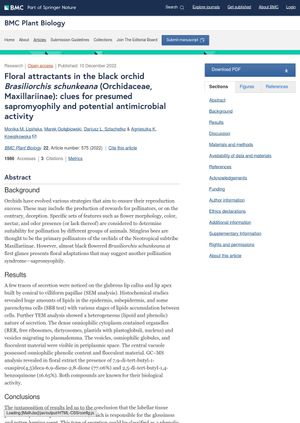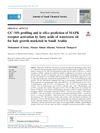Floral Attractants in the Black Orchid Brasiliorchis Schunkeana: Clues for Presumed Sapromyophily and Potential Antimicrobial Activity
December 2022
in “
BMC Plant Biology
”
7,9-di-tert-butyl-1-oxaspiro(4,5)deca-6,9-diene-2,8-dione 2,5-di-tert-butyl-1,4-benzoquinone steroidal antimineralocorticoid activity anti-androgen progesterone estrogen glucocorticoid diuretic antihypertensive heart failure ascites hypertension hypokalemia secondary hyperaldosteronism Conn's syndrome hirsutism androgenic alopecia acne seborrhea male pattern baldness antibacterial RNA polymerase inhibitor antiplasmodial spironolactone benzoquinone hair loss male baldness skin conditions antibiotic blood pressure medication

TLDR The black orchid Brasiliorchis schunkeana produces chemicals that attract certain insects and have potential antimicrobial properties.
The research paper investigates the pollination strategies of the black orchid Brasiliorchis schunkeana, focusing on its potential sapromyophily (attraction of pollinators that are attracted to decaying organic matter) and antimicrobial activity. The orchid produces a lipoid and phenolic material, giving the flower a glossy appearance and a scent similar to rotten herring. The chemical analysis revealed the presence of 7,9-di-tert-butyl-1-oxaspiro(4,5)deca-6,9-diene-2,8-dione (77.06%) and 2,5-di-tert-butyl-1,4-benzoquinone (16.65%), both known for their biological activity. These compounds are known to attract some Diptera, suggesting that representatives of this order could be potential pollinators of B. schunkeana. The study also found large quantities of lipids in cells, which could constitute a reward for pollinators. The former compound has been reported to have steroidal antimineralocorticoid activity and anti-androgen, weak progesterone properties, some indirect estrogen, and glucocorticoid effect. It is used primarily as a diuretic and antihypertensive, to treat heart failure, ascites in patients with liver disease, lowering hypertension, hypokalemia, secondary hyperaldosteronism, and Conn's syndrome. It is also used to treat a variety of skin conditions including hirsutism, androgenic alopecia, acne, and seborrhea in females and male pattern baldness. The latter compound, 2,5-di-tert-butyl-1,4-benzoquinone, is known as a potent antibacterial agent which inhibits the RNA polymerase enzyme and shows potent antiplasmodial activity. The quantity of both compounds detected in B. schunkeana is unprecedentedly high compared to other sources, suggesting that this orchid could be a more effective source of these two chemicals. However, the exact pollinator remains uncertain without further in-field studies.


